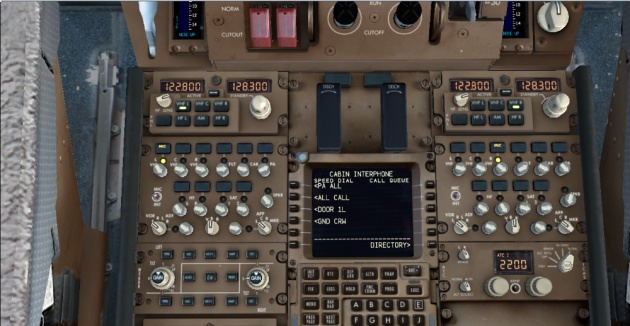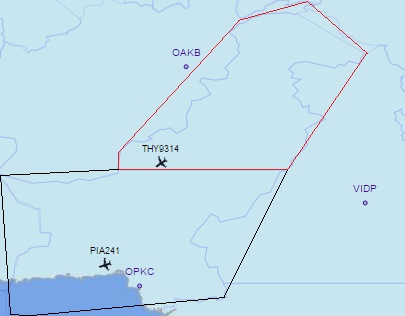 An Aviation Radar Display ( Source: www.adacel.com )
An Aviation Radar Display ( Source: www.adacel.com )
Topics Discussed In The Blog
- Introduction.
- Who is an ATC ( Air Traffic Controller)?
- Is Communication Between Pilots And ATC Important?
- How It Works?
- Reason We Switch Off Or Turn Our Phones To Airplane Mode During Flight.
- Different Air Traffic Control Stations Pilot Contacts Being In Flight..
- Videos On Air Traffic Control.
Introduction
Snice when the aircraft were, created, bringing them in commercial use was a great idea, but it seemed to be a hard task as no one knew how to navigate in the sky or even how to move from one city to another in an aircraft. That was because at beginning the aircraft was much more of a glider with no instruments, however engineers worked on it and planted different navigation sections in aircraft, but it still wasn't the solution of bringing these birds into commercial use, as it was really very dangerous. The pilot was flying without weather data , instruments can tell you where your destination is but they cant tell you where the runway is in those days, plus an instrument can fail too! So it was suggested that a pilot shall must be in contact with someone on the ground, throughout the flight, and hence they named that someone an ATC and this is system was named as Air Traffic Control.

Perth Airport Control Tower In 1962 ( Source: www.aviationwa.org.au )
Who Is An ATC?
An ATC is a person who is responsible for maintaining a smooth operation of air traffic within the range of his radar. An ATC give commands to pilots that pilot has to obey and execute. ATC is also responsible for different operations, like take off, landing, pushback and taxi, taking place on his airport. ATC is the one who clears the pilots to fly to their destinations. Without an ATC clearance the aircraft can neither take off nor land at the respected airport.

Some Nigerian ATCs learning Australian Method Of Air Traffic Control ( Source:www.aviationwa.org.au )
Is Communication Between Pilots And ATC Important?
The communication between pilots and ATCs is really very important, because due to increase in number of airlines and aircraft operating worldwide, we have a greater number of airplanes in skies today, which has increased chances of air collisions. Such incidents have taken place in past due to mistakes of ATCs. ATCs basically bring in and take out traffic in patterns to make the operations smooth. Other than that they tell pilots about the weather, direction of runway, active runways on the airport, inform them about the traffic near them, tells them the Barometric pressure values and many other things. However the pilots also give them information of state of aircraft, because in case of emergencies they are the only one to help.
A video showing an UTair B-767 and An A340 escaping something that could be a major accidents at Barcelona ( Source: https://www.youtube.com/watch?v=1N5THRSp4hM )
How It Works?
There is a Radio Pedestal having a complex radio communication and navigation system installed on an aircraft. This panel is responsible for communication between ATC an pilots and some navigational functions too. The pilots tune the frequency accordingly to the frequency of respected station. The VHF ( Very High Frequency ) signals are generated through all of this process, which are responsible for transmission of sound from aircraft to a station.

The following Picture Shows The Radio Pedestal Of B777-200LR, Here 122.800 Is Active Frequencys And 128.300 Is Standby Frequency ( Shot from MyMicrosoft FSX Aircraft B777-200LR Developed by PMDG )
Reason We Switch Off Or Turn Our Phones To Airplane Mode During Flight
Switching off or turning the phones to airplane mode is a part of a question that dose not have a satisfactory answer yet. Its a kind of an aviation myth. Some people believe that cell phones can interfere the navigation and communication system of the aircraft, however near me this is just a myth, because aircraft works on a phenomena that is different from working of the cell phones and also some airlines nowadays are allowing their customers to use the cell phones during flight. In aviation we always prefer a safe side, maybe that is why we are asked to switch off or turn to airplane mode during the flight. At last it dose not matter if you don't make a call for some hours, at least for the sake of safety.
Different Air Traffic Control Stations Pilot Contacts Being In Flight
To divide the work load and avoid the confusion between the Pilot, ATC communication, this whole system is divided into several stations which have their own responsibilities and which pilot contacts in the different phase of flight. We will discuss all these stations orderly below.
1. Clearance Delivery
This station is usually available at big Airports. Sometimes it might not be there. Its function is to clear the aircraft to its destination. Example of communication to this station is given below in which, suppose the aircraft with call sign PIA736 (Pakistan 736) parked at gate 24 with 150 passengers on board and with destination Dubai, is contacting delivery at Jinnah International airport Karachi.
" PIA736: Karachi delivery good morning! Pakistan736 at gate 24, 150 souls on board including cabin and cockpit crew, requesting clear IFR clearance to Dubai until waypoint TAPDO as filed with cruise at flight level 36000ft.
Karachi Delivery: Pakistan736 good morning! Information copied, cleared to destination Dubai until TAPDO via departure Badil3C, climb and maintain flight level 8000 initially, expect higher enroute, squawk 2314.
PIA736: Cleared to destination Dubai until TAPDO via departure Badil3C, climb and maintain flight level 8000 initially, expecting higher enroute, squawk 2314.
Karachi Delivery: Pakistan736, read-back is correct contact Karachi Ground on 121.800 for push-back and startup. Goodbye!
PIA736: Karachi Ground on 121.800 for push-back and startup, Goodbye! "
Now that our aircraft has clearance for its destination till waypoint TAPDO, where the Pakistani airspace ends, we can fly until that waypoint. After that we will have to contact Gulf ATC for clearance to continue for Dubai.
2. Ground Control
This station is nearly available at all airports and is contacted for clearance if Clearance Delivery isn't there. Ground Control, controls all the aircraft movements on the ground, however they don't have authority to control the runways. A ground controller usually has no radar and controls the aircraft with his visuals. They control the push-back, startup and taxi of the aircraft. Lets come to example where, our aircraft PIA736 which has clearance for destination will contact ground for push-back and startup.
" PIA736: Karachi ground good morning! Pakistan736 requesting push and start.
Karachi Ground: Pakistan736 good morning! push-back pull forward on taxiway K facing taxiway P, startup approved, contact when ready for taxi.
PIA736: Push-back pull forward taxiway K facing taxiway P, startup approved will contact when ready for taxi.
*PIA736 after Pushing-back*
" PIA736: Karachi ground, Pakistan736 is fully ready for taxi.
Karachi Ground: Pakistan736, taxi holding point runway 25L, via taxiway P and E, call when holding short of 25L.
PIA736: Taxiing to holding point runway 25L, via taxiway P and E, will call when holding short of 25L.
*PIA736 after taxiing to holding point 25L*
PIA736: Karachi ground Pakistan736, holding short of runway 25L.
Karachi Ground: Pakistan736, contact Karachi tower on 118.300. Good bye!
PIA736: Contacting Karachi tower on 118.300. Good bye! "

A ground controller guiding a Dash8 for parking ( source: videohive.net )
3. Tower Control
In absence of Ground Control, tower control must be contacted for clearance, push-back and startup. Tower control is available at every airport. Tower control's main function is to control the runways at the airport. They can clear the aircraft to land and take off. Let now PIA736 contact tower for take off.
" PIA736: Karachi Tower, good morning! Pakistan736 holding short of runway 25L, requesting departure.
Karachi Tower: Pakistan736 good morning! lineup and wait runway 25L.
PIA736: Lineup and wait runway 25L.
*PIA736 after lining-up runway25L*
Karachi Tower: Pakistan736, winds out of heading 060, 25 knots, cleared for take off, caution for birds.
PIA736: Caution copied, cleared for take off.
*PIA736 after takeoff*
Karachi Tower: Pakistan736, contact Karachi departure on 125.500, goodbye!
PIA736: Contacting Karachi departure on 125.500, goodbye! "
4. Approach/Departure Control
When an aircraft takes off the act as departure control, at the same time this control act as approach control for the incoming aircraft. It has a wide control area nearly covering radius of a whole city. It's basic function is to make a path for incoming and outgoing aircraft. Now let our aircraft PIA736 contact Karachi Departure while crossing altitude 3000ft.
" PIA736: Karachi departure good morning! Pakistan736 with you crossing 3000ft, 20 nautical miles away from BADIL.
Karachi Departure: Pakistan736 good morning! Radar contact, climb and maintain flight level 36000ft, proceed direct to BADIL.
PIA736: Climbing to flight level 36000ft and proceeding direct to BADIL.
*PIA736 about to leaving Karachi Departure Airspace*
Karachi Departure: Pakistan736 you are leaving my airspace, contact Karachi Center on 123.700. Good bye!
PIA736: Contacting Karachi Center on 123.700, good bye! "
5. Center Control
This is the station that controls all the aircraft, which are enroute, in it's area. It covers a large area. Pakistan has two Center Controls, which covers all the Pakistani airspace. Norther Pakistan and up-till waypoitn MOLTA is covered by Lahore Center, whereas southern Pakistan and upto waypoint TAPDO is covered by Karachi Center. So any aircraft entering Pakistani airspace will have to contact one of these centers according to their respected position. An aircraft contacts center when it enters its space, a center issues clearances while being in air, and a center also controls aircraft passing over its country.

The Picture Shows Map Of Pakistan And Estimated Range Of Lahore Center In Red Lines Whereas Karachi Center In Black Lines ( source: www.vattastic.com )
Now let our aircraft PIA736 contact Karachi Center so we can further understand the Pilot, ATC communication. In this blog this will be last station we will be contacting however in real we have to contact more stations according to the countries we will be travelling enroute.
" PIA736: Karachi Center good morning! Pakistan736 with you, crossing flight level 13000ft for 36000ft.
Karachi Center: Pakistan736 good morning! identified, proceed as filed.
PIA736: Roger, proceeding as filed, Pakistan736. "
This was very basic Pilot, ATC communication. However it's a bit complex while being in a real flight.
6. Flight Service Station (FSS)
Unlike the above station, the FSS isn't responsible to provide clearances or give any instructions, however they provide information to the aircraft in it's area, above certain altitude. FSS covers a very large area sometimes covering more than one country.
Videos On Air Traffic Control
How pilots communicate with air traffic control ( source: www.youtube.com/watch?v=TL_8ghkS2FI )
Departure Communications - from Startup to Cruise ( source: www.youtube.com/watch?v=2D_J4GUNI_c )
Basics of Communication ( source: www.youtube.com/watch?v=1cNYgjU9O6M )
VFR Communications ( source: www.youtube.com/watch?v=NAKAabmD2dA )
About The Author
Hey! I'm Abdalla Syed and I have been flying on Simulator, since past 4 years and am part of VATSIM community since past 1 year. Im VATSIM P1 rated pilot, P2 theory passed and practical check to go and Boeing 777 commander with PIAV. Flew Cross The Atlantic 2 times, 1 time participating in VATSIM GRAND CTP Event 2k15 (East bound). Also I have obtained S1 ground controller rating of VATSIM from Pakistan vACC. In real I'm a trainee pilot going through my basic training.
*Note: Feel Free To Ask Questions



